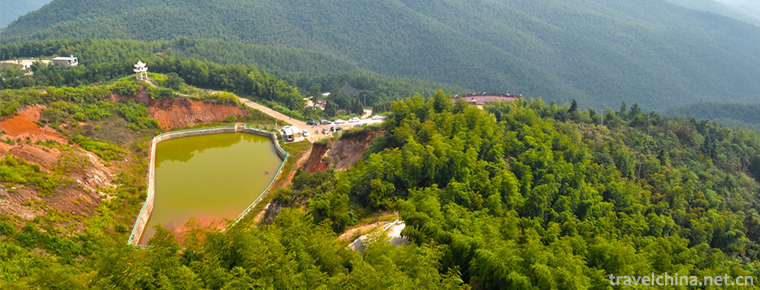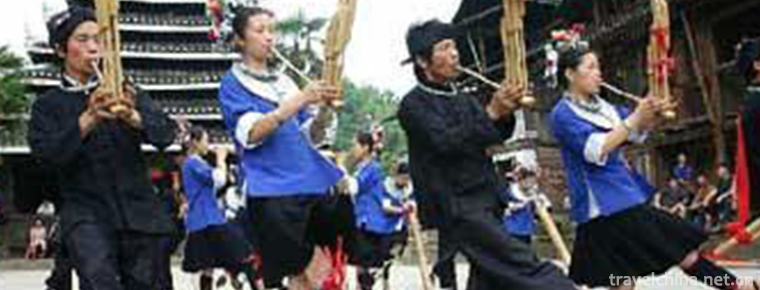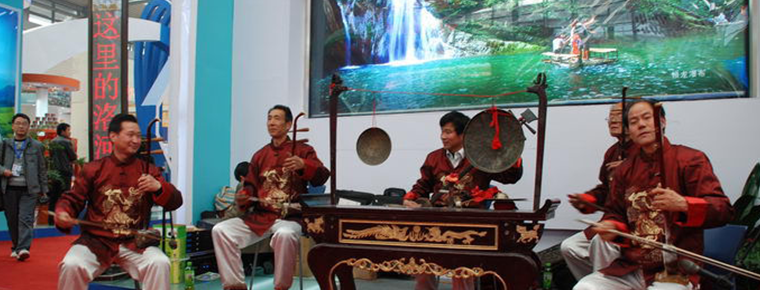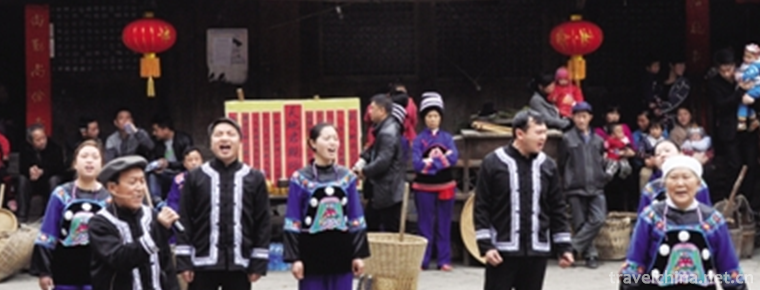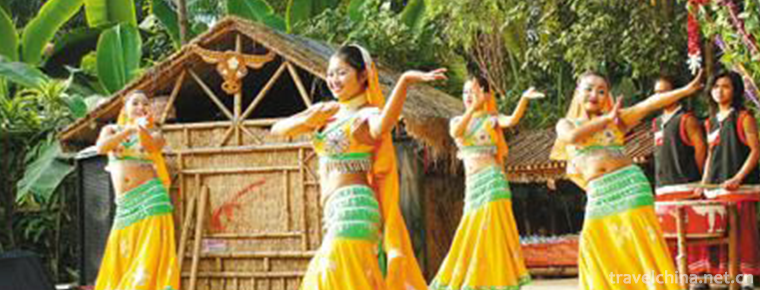folk song of northern shaanxi
folk song of northern shaanxi
Northern Shaanxi folk song is a traditional folk song in northern Shaanxi, which can be divided into three categories: labor chant, Xintianyou and minor. Labor chants include tamping song, blockbuster song, quarry song, cattle song and field song. Xintianyou is divided into high-pitched and peaceful-pitched. These traditional folk songs, which have their own styles and characteristics, reflect social life from all aspects, singing the bitterness, joy and hatred of the people in northern Shaanxi, and when the social system changes fundamentally, the content and form of folk songs also change. This change reflects a new social life and a new character image in content, and at the same time makes various genres have a new significance.
In June 2008, the northern Shaanxi folk songs declared by Yulin and Yan'an cities in Shaanxi Province were listed in the second batch of national intangible cultural heritage lists with the approval of the State Council.
History of Development
cultural background
North Shaanxi is located in the Loess Plateau, east to the Western Jin Dynasty, south to Tongchuan, West to Ningxia, Gansu and north to Inner Mongolia. Since ancient times, there have been frequent wars, so that the ecological environment has been severely damaged. Over the years, a vast gully of landform has been formed. In this living environment, people in northern Shaanxi have developed an optimistic, heroic, diligent, brave, honest and simple character. Folk songs in northern Shaanxi are the product of the collision between the vast plateau terrain and the profound and simple feelings of people in northern Shaanxi. They are the reflection of people's lives in northern Shaanxi, the faithful record of social history in this area, and an epic of life created by tens of millions of working people collectively. It is also a cry of the soul for freedom and happiness.
Northern Shaanxi is the birthplace of Chinese civilization. Historically, Han people and ethnic minorities frequently exchanged with each other. With the constant war and great population mobility, they gradually stabilized in the Yuan Dynasty. In this context, the folk songs of northern Shaanxi have the traces of the integration of multi-ethnic cultures in the Northwest region, and at the same time change the national psychological characteristics and aesthetic forms of culture and art in this region. Since ancient times, northern Shaanxi has been a region of ethnic integration. Due to the special natural environment, folk songs with rough style and strong local characteristics have been formed. Northern Shaanxi people are Han people, but because of the mixed ethnic groups, the continuous integration and reorganization of ethnic origin, compared with other Han people, northern Shaanxi people are no longer pure Han people. The integration of blood has brought the advantages of ethnic groups, but also precipitated the psychological characteristics and expression of the relevant ethnic groups, such as: the nature of northern Shaanxi people to be good at singing and dancing has created the art of singing and dancing while "Flowers", "Yangko", "Dry Boat" and so on.
It is precisely this profound regional cultural connotation and special geographical location and characteristics that gradually formed the strong cultural background of northern Shaanxi, that is to say, under this background, the unique artistic expression of folk songs in northern Shaanxi was formed.
Form of Origin
The origin of folk songs in northern Shaanxi originated from the historical changes in northern Shaanxi. "Northern Shaanxi" as its name implies is the northern part of Shaanxi Province, referring to Yan'an City and Yulin City. Folk song is the simplest form of art. It was born with the labor and life of the people of northern Shaanxi and the history and folk activities of northern Shaanxi.
Initial Evolution
Concentration of Language and Culture
Historically, the northern Shaanxi and Hetao areas have been the areas where the Central Plains regime and the Northern Minority Regimes competed for grabs. Until the Song Dynasty, the area was mainly controlled by the Jin and Xixia Minority Regimes in turn. Agricultural culture and nomadic culture coexisted with each other.
After the failure of the Mongol-Yuan regime, the Chinese nation basically achieved unification. During the Ming Dynasty, the government organized many times to immigrate from the densely populated areas of western, central, southern and southern Shanxi to northern Shaanxi. Because most of the immigrants were from Jin, the Jin language family was formed in northern Shaanxi. The Jin dialect family occupied the northern Shaanxi plateau with a strong front, and at the same time brought the Central Plains culture with Jin culture as the main part. Of course, the language of the original inhabitants is also largely preserved, such as the village names of Yanchuan County: Cheguri, Longerze, Rabbit Guli, etc., which fully show the tone of the northern minority. In the northern Shaanxi dialect, "Da" - father, "Keqingmacha" - simply and neatly, should be the original resident language. The language of the occupied nation is stubbornly left on its original land.
Initial Forms of Civil Communication
The immigration movement of Ming Dynasty made the population of northern Shaanxi develop greatly. The cultures of Mongolian, Hui and Han nationalities merged here. The exchange of Yangko, Taoism, storytelling, Errentai, Yulin minor and folk songs with the local culture formed the unique folk art of northern Shaanxi. At the end of the Ming Dynasty, the local people lived a miserable life. Folk songs were easy to express their feelings and feelings. Folk people used this form to reflect life and society, regardless of occasions. The more primitive Xintianyou folk song, which reflects the working life of the people in northern Shaanxi, has only three tones.
At the end of Qing Dynasty, folk songs gradually matured and formed a certain tune. Qupai has been handed down all the time. The peasant uprising in the late Ming Dynasty produced Yingchuanwang during the outbreak of northern Shaanxi. For example, the tune of troops reflects the historical facts of the suppression of the Hui uprising by the Manchu and Qing governments during the fifty-six years of Shunzhi in the Qing Dynasty. In the mid-Qing Dynasty, the government further opened up the land along the Great Wall and Hetao area, attracting a large number of men from northern Shaanxi counties to work and traffick, forming a "go west" movement. In the process of departure from home and hard journey, a large number of folk songs such as "going to Xikou", "catching animals" and "throwing tear eggs and eggs in the Songlin of Shasong" have been formed.
Before the 1930s, the folk songs in northern Shaanxi were compiled and sung by the people of northern Shaanxi according to their own life and customs. In the life scenes of cultivated land, rushing, grazing, drinking, festival, building houses, birthday celebrations, weddings, funerals, marriages and temple fairs, they gradually formed a high-spirited, bold, rough and melodious style. They were popular through oral transmission and singing, and flourished through collective compilation. Different aspects reflect the people's life, historical evolution and social changes in northern Shaanxi.
development history
Northern Shaanxi folk songs have long been in an informal cultural element due to the limitations of natural and social conditions. The collection, collation and research of northern Shaanxi folk songs as a regional cultural form began in the 1930s. With the development of China, the study of folk songs in northern Shaanxi has gone through four stages: the start-up stage, the development stage, the stagnation stage and the period of enrichment and soaring.
Yan'an Start-up Period
Yan'an Period mainly refers to the period from 1935 when the Red Army joined forces in Wuqi Town, Northern Shaanxi Province, to 1948 before the Chinese Communist Party crossed the Yangtze River. During this period, Yan'an was the seat of the central government of the Communist Party of China, and also during this period, folk songs in Northern Shaanxi ushered in their own development period.
After the founding of the Communist Party of China in northern Shaanxi, the Luxun Academy of Art and Music was specially established. The senior class of Luxun Academy of Art and Music launched the "Folk Song Research Society", dispatching a large number of professional literary and artistic workers to collect and organize local folk songs systematically, comprehensively and in large quantities. This folk song collection is the first large-scale folk song collection activity in the history of modern China. Its main purpose is to cooperate with the current revolutionary struggle, but it objectively retains thousands of valuable folk songs and other folk music. Because the main purpose at that time was to serve the war, most of the works tended to be contentious, educational and propaganda, and neglected those works that did not conform to the theme, resulting in incomplete types of works collected. Collection works are mostly professional artists, they are mostly to seek creative inspiration from northern Shaanxi folk songs, but they pay more attention to the songs but ignore the lyrics, resulting in many folk songs only music without lyrics, virtually losing the vitality and integrity of northern Shaanxi folk songs.
The Promotion Period of New China
After the founding of New China, all activities and work have been carried out in a completely new way. China's main development direction and mode have changed, and the corresponding attitudes and measures to literary and artistic work have also changed. At that time, most of the folk songs in northern Shaanxi were songs singing about the beautiful life of the motherland and the new socialist climate. The collection of folk songs in northern Shaanxi was formally incorporated into the daily work of the government's cultural authorities. The Society of Literature and Art Studies of New China once again collected, sorted out and arranged the folk songs in northern Shaanxi. On the original basis, the folk songs in northern Shaanxi were supplemented. At that time, the folk songs in northern Shaanxi were mainly disseminated. Some folk songs reflect the new society and life. During this period of social transformation, people's political outlook and spiritual state were improved, which greatly promoted the development of folk songs in northern Shaanxi.
Stagnation during the Cultural Revolution
During the ten years of the Cultural Revolution, social unrest, literature and art were in a dark stage. Many excellent literary works were destroyed and destroyed by autocracy. Many literary and artistic workers were killed. Therefore, the theoretical study of folk songs in northern Shaanxi was in a standstill. Because of the seriousness, autocracy, terror and arbitrariness of the social environment, folk songs in Northern Shaanxi lost their vitality for development. At this stage, folk songs in northern Shaanxi lost their innovation. Most of the colors and vitality of the times are filled with content that meets the political needs of the time on the basis of the songs collected before. The typical way of using old bottles to bottle new wine makes the folk songs in northern Shaanxi have the color of formalization and politicization. The folk songs in northern Shaanxi in this period were branded by class.
New Period of Reform and Opening-up
After the end of the Cultural Revolution, China began to rectify the chaos in the political sphere and redefined the policy of "letting a hundred schools of thought contend and a hundred flowers blossom". Therefore, the literary and artistic undertakings began to recover gradually and ushered in a new spring of development. Folk songs in northern Shaanxi also entered a new period of rapid and diversified development. On the one hand, the collection and arrangement of folk songs in northern Shaanxi has once again aroused an upsurge, which has attracted the attention of literary and artistic institutions and literary and artistic workers. On the other hand, it expands the research horizon of northern Shaanxi folk songs, and the study of northern Shaanxi folk songs has changed from a single mode to a pluralistic stage.
artistic characteristics
Stylistic features
The long history has endowed northern Shaanxi with rich national cultural traditions. Due to the special cultural background, the folk songs of northern Shaanxi with strong local characteristics, such as broad and free style, frank and sincere, warm and generous, have been formed. Its artistic charm lies in the two aspects of Ci and qu, which is the harmonious unity of music art and language art.
Lyrics of Folk Songs
Folk songs in northern Shaanxi have gradually formed a certain standardization and strictness in the form of melody and lyrics through the continuous polishing and processing of the working people in the process of wide spread. The sentence structure of folk songs in northern Shaanxi is mainly composed of upper and lower sentences, with two suffixes rhyming to form a paragraph. Among them, Xintianyou is the most typical, and its prominent expression is the artistic technique of "Bixing". Compare the other with the other and prophesy the other. Xintianyou is usually a two-sentence style, the first sentence is a comparison of interest, the next sentence is a topic, such as: "Five grain in the field of seedlings, only sorghum Gao, the daughter of thirteen provinces, only the blue flower is good." The lyrics usually begin with a daily language that people are used to, arousing the interest and eliciting what they want to say later. For example, "Leaves are green, leaves are yellow, leaving a little sister in panic". In addition, the lyrics also use interlining words and interlining sentences, such as "the mule at the head of the song yo, three individual lamps", of which "that" and "yo" are interlining words. In "Miss Sister takes a mandarin duck fan and sits on a jade railing, a pair of spiders look at peony, and a pair of spiders look at peony," the phrase "spiders look at peony" is used as a foil. Among the numerous folk songs in northern Shaanxi, songs describing love are the most common.
Rough and bold folk songs in northern Shaanxi also have soft beauty. The sister who sent Lang to Xikou in "Go to Xikou" told him, "Never make friends, make many friends, afraid that you will be tortured. He is a friend who has money. He has no money to look at. Only the little sister is me, and it lasts forever and forever." The words and sentences show the true feelings, the lyrics are simple and natural, with profound meanings. The colloquialism of lyrics is also a feature of folk songs in northern Shaanxi. The folk songs in northern Shaanxi use local dialects, which are not only friendly and moving, but also have a lively rhythm and smooth charm.
Dialect Characteristics
First of all, the most important feature of the colorful folk songs in our country is the difference of dialects, so-called "different languages across mountains, different sounds across water". The special feature of northern Shaanxi dialect lies in its skillful reduplicated words and rich reduplicated words. Only these reduplicated lyrics can give birth to the folk song of northern Shaanxi, which is a wonderful work of art, touching human feelings and pleasing soul. For example, "Bai Gesheng has a face, broken teeth and words of annoyance" is the vivid form of the northern Shaanxi dialect itself, which adds a lot of artistic charm to the northern Shaanxi folk songs. Secondly, the northern Shaanxi dialect emphasizes nasal sounds, and the vowels ending with "n" are pronounced as "ng". Therefore, for example, the word "man" in "desperate man" should be pronounced as "still" in singing, while the pronunciation of "shan" and "xia" in "guerrillas coming down from Hengshan" should be pronounced as "san, ha". Northern Shaanxi folk song singing pronunciation should be advanced, close to shouting, weak resonance, is a natural and simple voice based on voice. It changes tones such as "Yinping" and "Yangping" in the four tones of Putonghua, according to the phenomenon of voiceless, such as the first "English" in the Lyric "Blue Blossom" and "Miaozi Tian in Wuguli (the one in Wuguli). ” The word "li" in the Chinese character is sung according to the feeling of four tones. Thirdly, the lining words and tunes in the folk songs of northern Shaanxi also have strong local language characteristics. The strong dialectal tone and tune is one of the important factors that make the folk songs of northern Shaanxi unique. The use of the lining words is also an important feature of the folk songs of northern Shaanxi. The addition of some lining words in the singing not only makes the singing language more colloquial, the music more full and coherent, but also enables the singer's mood to be obtained. More full play. Such as "that" and "yo, ah" in Blue Flower, we should not neglect this step in singing, otherwise the charm of the song will be much worse.
Curvilinear structure
Due to the production of folk songs in northern Shaanxi, there are many works from the smaller two-sentence pattern to the larger multi-paragraph style. The two-sentence and Four-Sentence patterns are the most common forms of folk songs in northern Shaanxi. The upper and lower sentences constitute a paragraph, two sentences and one rhyme, and change freely. The number of basic words in each sentence is seven words, such as "Thirty Lipu", "Footman Diao", "A Pair of Brothers with Mao Eyes" and so on. However, due to lyric and narrative needs, sometimes the seven-word sentence pattern is expanded, with more words in the sentence pattern, and the extended three-sentence or five-sentence structure of the subsection song, etc. The structure and speed of some folk songs in northern Shaanxi have changed in varying degrees with the need of content and lyric language in the repeated use of multi-paragraph words, forming a large structure full of changes and smooth running. Such as "Five Brothers Grazing Sheep", "Shandandan Blossom Red and Brilliant" and so on. In a word, the structure of folk songs in northern Shaanxi is flexible and rich, and the content covers a wide range.
Classification of Folk Songs
First, the types of folk songs in northern Shaanxi can be roughly divided into chant, Xintianyou and minor according to the content, form and genre of their singing.
Chant
The trumpet is a folk song singing directly with labor, usually in collective labor. The trumpets in northern Shaanxi mainly include the trumpet T of the Yellow River ship, the trumpet tamping and the trumpet hitting. From Qinghai, the Yellow River flows through Gansu, Ningxia and Inner Mongolia, to Fugu County in northern Shaanxi, along the Shanxi-Shaanxi Grand Canyon. Shipworkers mostly travel between the two sides of Shanxi and Shaanxi, making a living by ferry and short-distance transportation. The most famous ship laborer of the Yellow River is the Yellow River Boatman's Song.
Tamping and dumping (also known as Lajie) are important forms of labor in northern Shaanxi plateau. There are many earth and rock works in northern Shaanxi. Kilns and dams are built to be tampered and dumped. Therefore, dumped and dumped trumpets have become more common forms of singing in labor trumpets in northern Shaanxi. These two trumpets are only improvised to unify labor movements and activate emotions when they hit the foundation or pile. The representative repertoire of tamping chant includes "tuning in", "gently rising and slowly playing" and so on. The representative repertoires of the "blockbuster" include "The Beauty of this blockbuster" and "The Tasteful Sister-in-law in the Country".
Xintianyou
Xintianyou is the most important and representative folk song genre in northern Shaanxi. Xintianyou's tune is composed of two phrases, the first one is more open, the sound area is higher, the music span is larger, the second one is more closed, the melody is tortuous and downward, showing narrative characteristics. Xintianyou's tunes can be roughly divided into two types, one is the type of folk songs with high and open tones and relatively free rhythm, the other is the type of minor tunes with smooth and stretched tones, well-proportioned and regular rhythms and stricter structure. The former is representative of songs such as "footman tune" and "orchid flower", while the latter is representative of songs such as "everyone says we are good" and "your mother beats you out of shape". Xintianyou is a kind of folk song bred on the Loess Plateau, which is highly random, interesting, heartfelt, unrestricted and expressive. Its name is varied, and it is called "mountain music", "mountain climbing tune" and "traveling with the sky" in different places. Xin Tian you is the quintessence of Northern Shaanxi. It can best reflect the melancholy, bleak and magnificent personality of the Loess Plateau in Northern Shaanxi. Its singing space is very strong, high spirited and rustic and simple, its rhythm is free and simple and generous. It emphasizes the description of inner feelings, plain and no grain, and is truly touching, so it can break through time and space, spread like wildfire, and spread from generation to generation.
minor
The minor is also called ditty. Its structure is more regular and its tune is more euphemistic and smooth. It has the characteristics of tortuous and delicate expression. Shaanbei minor can be divided into general minor, silk string minor, Yangko minor, custom minor and chanting minor. Minor tune is a kind of city folk song processed by folk artists. It covers a wide range and has a complete structure. It is a more "artistic" type of folk songs in northern Shaanxi. Such as "Walking West Pass", "Thirty Mile Shop", "Tackling Work" and so on. Its language is vivid, simple, melodious and graceful, deep and sincere feelings, emotional depiction is subtle.
Performing Form
North Shaanxi folk song is good at using the method of "Bixing". By means of Bixing, we can stimulate people's Association and imagination, and make people understand more simply and thoroughly. At the same time, folk songs in northern Shaanxi are good at expressing their minds directly, expressing their inner feelings through some easy-to-understand language, or expressing their depression, or expressing their love for their lover, or expressing their hearts of sorrow. Folk songs in northern Shaanxi usually take things in life as subjects, which are rich in content. By introducing some common trifles in people's lives, they express their inner feelings. Because of gender differences, men and women sing differently. Men mainly talk about the hardships of struggling outside, earning money to support their families, having to leave home for the sake of life, accompanying them through long and hard days with these songs; while women mostly talk about love, they express their longing for love through songs, and experience the love in love. A little.
Singing Characteristics
The singing characteristics of folk songs in northern Shaanxi are an important aspect of their artistic language. To master the artistic language expression of folk songs, we must start with the singing methods and techniques of folk songs in northern Shaanxi. The singing methods of folk songs in northern Shaanxi are rich and varied, forming its own singing style and relatively complete singing system. The wide range and large rhythm beat determine that attention should be paid to the combination of true and false sounds, the use of tone-moistening techniques and the performance of voice, intonation and tone in such singing means as timbre, volume, speed and rhythm. The main singing characteristics are summarized as follows:
Long-tone singing
Northern Shaanxi people's rough and bold character determines the straightness of their music and the rise and fall of the melodic line, straight up and down, especially the treatment of long tones in the melody is basically straight singing. The straight tone in the folk songs of northern Shaanxi is generally strengthened, such as shouting at someone on the opposite hill: "Hey, come back!" Moreover, straight tones are processed into trumpet cavity <, olive cavity <>, conservative cavity -> oral receipt according to the emotional needs of different works, and long tones appear in the form of straight tones. For example: "Upper slope (Ouch) Ouch, next Ouch Liang Yo, think of that little sister, Ouch, Ouch, Ouch, Ouch" in the "Ouch" are singing in straight tone, according to the emotional strength, speed, timbre of different treatment, a long sigh of resentment, the backlog of words are sung through songs, this straight-tone singing is northern Shaanxi folk singing tools. Representational singing methods.
Break-up singing
A broken cavity is also called a dumb cavity and a dumb sound. There are "one word number break" and "one tune number break" in northern Shaanxi folk songs. There are "one light one weight" and "one receipt one release" breaks. In the northern Shaanxi "playing silk strings" music, there is a singing method of more than one word. Singing is intended to sing every note truly and truly, and to explain every word clearly. For example, in the song "Playing on the Swing", the breaking of the tune should emphasize the words, and be light and quick to express the lively and handsome image of the two sisters. In the minor "Bachelor Crying Wife", the breaking of the tune should be short and heavy to depict the sad feelings of the single "crying" wife. In a word, the breaking tone should be flexible, short, fast and ingenious. The breaking tone in the interlining and supporting tone is usually a decorative phrase. When singing, we should pay attention to the characteristics of the interlining and the extension of emotion. We should sing vividly, naturally and full of life flavor.
The Singing Method of Lining
Lining tone is widely used in folk songs of northern Shaanxi. It has emotional rendering and needs to be sung lightly and skillfully. In addition to some commonly used Interjections and auxiliary words such as hey, yo, ah, hey, hum hey, which and so on, there are also some long-term inherited linings, such as "Taiping Year", "Yang Liuqing", "Swing Three Sways" and "Begonia Flower". They have formed a fixed format and scale for the foil and foil of the right words, and can be used when they meet the words. The most emotional words in the foil are some words and onomatopoeia, such as "the mother of the child" at the end of each paragraph in "Bachelor Crying Wife", "the little widow going to the grave" with "wow" or "God" crying words at the end of each paragraph, as well as the frequent occurrence of Xintianyou. For the lover, they are called "Ouch kiss" and "Ouch fate". They are the natural expression of emotional language in daily life. Some song linings have formed an independent musical passage, which, in contrast with the main paragraph, renders the atmosphere, increases the entertainment and adds to the aesthetic feeling of music. When singing, we should pay attention to the contrast of color between the two parts, and the main part should be singing delicately and coherently. The lining part should be sung lightly, and "Del" should be sung quickly and loudly. Every word should be sung shorter, preferably as a tune.
Skateboarding
Skateboarding is another singing skill in folk songs of northern Shaanxi. In singing, there are skateboarding, big skateboarding, casting, pushing, playing and doubles. There are various subtle changes in the types, intensity, speed and timbre of voice in different works. For example, in Cattle Spirit, the word "head" is slipped and the word "three" is slipped. For example, almost every word of "spinning and turning" in "eating and wearing", "squeaking" and "sound" has a sliding tone. The singing of sliding tone combines with dialect and is full of edges and corners. It is important to bite out the delicate charm of folk songs, to express a variety of emotional connotations, and to reflect the characteristics of different styles. When singing, the breath is active, flexible and flexible. Every note is sung smoothly and naturally.
The singing methods of FA and Xi
The most prominent feature of northern Shaanxi folk songs in tone aspect is that they are widely used with a scale of falling Xi and rising fa. This seven-tone or even eight-tone series consisting of Solla descent, xidoremi ascent and FA isophony is called "bitter scale" or "variant Qing quotient scale". In the folk songs of northern Shaanxi, not only the strong color tones with Down Xi and up fa, but also the up do tones sometimes appear. The appearance of these special tones makes the folk songs of northern Shaanxi more moving and unique. Jiangxi is a slightly reduced xi, which is slightly lower than the standard xi, slightly higher than the reduced xi. It is a sound between Xi and reduced xi. To ascend FA to ascend FA is a sound between FA and ascending fa, and ascending do is a sound between do and ascending do. This is when singing "special" treatment, combined with works often sing out the pharynx cavity, nodding cavity, late cavity, to sob, singing out the charm.
Genre Art
Folk Opera Troupe
North Shaanxi Folk Song Art Troupe
In June 2015, the Northern Shaanxi Folk Song Art Troupe was formally established. The troupe is a cultural experience entity with the theme of Northern Shaanxi Folk Song in China. It is based on the idea of benefiting the people through culture. The troupe takes Wang Xiangrong as its national non-hereditary successor. Lead young actors Wang Jianning, Gao Lin, Ding Huicheng, Su Wenwen, Liu Meiyu, Yan Jinyuan, etc. to integrate folk songs resources in northern Shaanxi and explore the inheritance and development of folk songs in northern Shaanxi.
North Shaanxi Folk Song Museum
At the beginning of 2017, the Yuyang District Committee and the District Government decided to build the North Shaanxi Folk Song Museum. In April, we began to collect and sort out various kinds of folk songs in northern Shaanxi, such as literature, pictures and objects, in order to fully display the historical origin, development context and spiritual features of folk songs in northern Shaanxi. Shaanxi Yuyang North Shaanxi Folk Song Museum is based on the classical North Shaanxi Folk Songs telling about the development of society, history, art and Folklore on the Loess Plateau, supplemented by exhibits in kind. It integrates the rough and lively form of folk songs in northern Shaanxi with the desolate and solemn connotation beautifully, cooperates with modern exhibition techniques, carefully arranges and reasonably arranges, so as to give more audience in the limited space as possible. Feeling, inspiring and experiencing. The total building area of the museum is 11800 square meters, of which the exhibition area is about 5680 square meters, and the public decoration and supporting function exhibition area is about 6120 square meters. After the completion of the North Shaanxi Folk Song Museum, the rich artistic connotation and endless musical charm of the North Shaanxi Folk Song will be sublimated in space, which can meet the needs of the broad masses of people to appreciate and learn folk song art, and become a new platform for the innovative development of Chinese Folk Song, so as to popularize and promote the North Shaanxi Folk Song Art.
Dissemination area
Broadly speaking, folk songs in northern Shaanxi are spread throughout the country. From 1935 to 1948, a large number of the best Chinese musicians of the 20th century, led by Xian Xinghai, gathered in Yan'an to learn the folk songs of northern Shaanxi, and adapted and created many works with the style of northern Shaanxi. They played an important role in the war of resistance against Japan and the war of liberation. After the founding of New China, many folk songs of northern Shaanxi, such as "Orchid Flower" and "Thirty Miles Shop", spread throughout the country and were popular among the masses. Love. In order to inherit and develop the folk songs of northern Shaanxi and develop the folk chorus art with multi-voice chorus, the Central Song and Dance Troupe established the folk chorus of northern Shaanxi in 1952. In 1954, it toured ten cities throughout the country, and adapted the chorus repertoires of "Thirty Lipu", "Orchid Flowers", "Embroidered Lotus Bag" and so on. Shanghai Record Factory produced records for some of the chorus, which were popular throughout the country and broadcasted by the central people. The station also recorded some tracks and broadcast them to the whole country.
In a narrow sense, it takes northern Shaanxi as its center and spreads widely in its surrounding provinces and regions. North Shaanxi lies across the Yellow River from Shanxi to the east, in Gansu and Ningxia to the west, in the Inner Mongolia Ordos prairie to the north, in the Guanzhong Plain to the south, and in a special geographical location, which provides convenient conditions for the spread of folk songs in northern Shaanxi in Shanxi, Gansu, Ningxia and Inner Mongolia. In Shanxi, the folk songs of northern Shaanxi are the reserved repertoire of many folk singers. The most typical representative is the Shanxi native singer Abao who sings the folk songs of northern Shaanxi. The folk songs of northern Shaanxi are often sung on different occasions by some diffuse tunes and Errentai singers in Zhungeer Banner of Inner Mongolia. Wuchuan County, Inner Mongolia, known as the "hometown of mountain climbing tune", the inheritor of mountain climbing tune, Wusanjun, participated in the mountain climbing tune competition held in Hohhot three times, and won the first prize by singing folk songs of northern Shaanxi. In many folk songs competitions held in northern Shaanxi, singers from Gansu and Ningxia also participated.
representative figure
Pi Enfeng
China's famous singer, a national first-class actor, is known as the "Silver Bell on the Loess Plateau". Director of China Musicians Association, Director of China National Minority Vocal Music Society and Honorary Head of Shaanxi Radio and Television National Orchestra.
Wang Xianglong
Famous folk singer, born in 1952, Fugu people in Shaanxi Province. As a representative figure of folk singers in northern Shaanxi, Wang Xianglong has been praised as the "King of Songs in Northern Shaanxi". His passionate singing style includes not only the desolate and heavy folk songs in northern Shaanxi, but also the local flavor that makes people in northern Shaanxi feel close and authentic. Wang Xiangrong is a talented performer of folk songs in northern Shaanxi. He is bold, straightforward and artistic.
He Yutang
Born in 1949, director of Ansai County Culture Bureau, Shaanxi Province, member of Shaanxi Branch of China Folk Artists Association. Vice President of Yan'an Quyi Artists Association. In 1986, He Yutang won the second prize for singing and the third prize for creation in the first Chinese folk music competition. He Yutang was officially named "King of Folk Songs" by the Central Propaganda Department.
Sun Zhikuan
Yulin Civil Art Troupe soloist, famous folk singer, Shenmu County, Yulin City, Xintianyou "King of Songs". In 1986, he participated in the first national folk song popular song contest and won the Golden Peacock Cup. Later, he won the gold medal of the National Folk Song Contest twice and the first prize of the Shaanxi Art Festival.
Guo Yunqin
The soloist of Yulin Civil Art Troupe, a native of Mizhi County, Yulin City, is known as the lark on the Loess Plateau. In 1986, he won the excellent singing prize of the First National Folk Song Popular Song Competition and the first prize of Shaanxi Art Festival twice. There are albums of singing. He has visited Europe, Japan, Hong Kong and other places.
Wang Erni
Wang Erni was born in 1985 in Fengjiawan Village, Daheta Township, Yuyang District, Yulin City. In 2005, he was awarded the first "Top Ten Youth" title in Ansai County. He was the lead singer in the movies Xintianyou and the TV musical Walking West Kou.
Hao Quanlin
The soloist of Yulin Artistic Troupe. State second-class actors, folk singers, members of Shaanxi Musicians Association and Drama Association.
Lucuilian
Suide County Loess Art Troupe soloist, Yulin Suide County. He has won the first prize in Yulin and Shaanxi folk song contest. Several folk songs sung by her were collected, published and broadcast by China Record Company and Shaanxi Music Radio.
Representative Works
The representative repertoires of folk songs in northern Shaanxi mainly include Oriental Red, Walking West, Catching Animals, Orchid Flowers, Stir-fried Noodles, Five Brothers Herding Sheep, Planing Potato, Embroidered Golden Plaque, Loess Plate, Thirty-mile Shop, Embroidered Lotus Bag, Wanting Kinship, Nanniwan, Calling a Brother Come Back Quickly, Yellow River Boatman's Song and Nine Points. Quyangge Yellow River Front, Autumn Harvest, Turning over Dao Qing, Brothers and Sisters Opening up Waste Land, Di Liang Liang, Tear Eggs and Eggs Thrown in Artemisia annua Forest, Shandan Blossom Red and Brilliant, etc.
Cultural Inheritance
Inheritance influence
First, folk songs in northern Shaanxi should be innovated on the basis of maintaining their original characteristics and musical quality. North Shaanxi folk song has always maintained its vigorous vitality. One of the reasons is that its artistic form and cultural connotation are formed in the constant collision and change with the new culture in the years. Therefore, although folk songs in northern Shaanxi have important value of musical tradition, they are inevitably facing changes. Folk songs in northern Shaanxi must survive in the process of changing and unchanging. On the basis of keeping the original music quality of folk songs in northern Shaanxi and not destroying their traditions and characteristics, and on the premise of satisfying and enriching the aesthetic requirements of contemporary people, it is necessary to explore the communication with modern culture, properly combine the thinking and techniques of contemporary music and integrate them into modern life. It is the innovation and development of folk songs in northern Shaanxi in the new era. The core of the exhibition.
Secondly, the government is always the leading link, and its role and strength are the greatest. The correct policy and good guidance of the government will effectively improve the folk songs in northern Shaanxi. In terms of labor security, the relevant government departments should be able to solve the living conditions of many artists and singers and provide them with a relatively stable living environment. The government can regularly organize folk songs competitions in northern Shaanxi to provide a platform for singers and people who love folk songs in northern Shaanxi. Packing and publicizing the winning singers, promoting them to the media of the whole province and the whole country, encouraging them to study and sing the folk songs of northern Shaanxi, expanding the influence of folk songs of northern Shaanxi; calling professional creators, adapting and compiling old folk songs of northern Shaanxi, creating new folk songs of northern Shaanxi, collecting excellent new folk songs of northern Shaanxi, compiling books regularly, and producing accompaniment bands to enable singers They have a large choice, but also facilitate the spread of new songs; organize experts, scholars, creators to go to the grass-roots level for folk songs collection, collation, research and so on.
Thirdly, we should attach importance to the cultivation of talents and let the folk songs of northern Shaanxi come into the classroom, starting with children. In the classroom of northern Shaanxi, local culture courses should be added, and the teaching of folk songs in northern Shaanxi should be integrated into the teaching materials. The training center of "folk songs in northern Shaanxi" can also be set up to train singing talents and improve and strengthen the singing team in the continuous accumulation.
As an intangible cultural heritage, the protection of folk songs in northern Shaanxi has a long way to go. It is not an overnight utilitarian measure. It requires the dedication and practical efforts of generation after generation of enthusiastic people of lofty ideals. Only in the continuous singing process can the folk songs in northern Shaanxi exist and be a living art and still flourishing and developing. Art. Folk songs in northern Shaanxi will eventually emerge from the Loess Plateau and evolve from a regional folk song into a cultural and artistic character full of unique charm.
Inheritance value
Folk songs in northern Shaanxi reflect the rich content of social life. Nowadays, most of the popular folk songs in northern Shaanxi came into being from the end of the 19th century to the 1940s. They reflect not only the content of social change, but also the content of "long-term work song". They reflect the people's resistance to the oppression and exploitation of the feudal unified class in northern Shaanxi, especially the revolutionary historical folk songs. They are a group of precious revolutionary historical materials. Such as the famous "When the Red Army's Brother Comes Back" and "Shandandandan Blossoms Red and Brilliant" are of great value. First, the value of language and culture: the art of folk songs in northern Shaanxi is the art of language in northern Shaanxi, which has been spreading for a long time and has a wide influence. For a long time, it has accumulated a large number of ancient and primitive northern Shaanxi dialects, which are widely distributed and original. It provides many vivid first-hand materials for the study of local languages in northern Shaanxi. Second, the value of history and culture: folk songs in northern Shaanxi record people, events, things and feelings of people in northern Shaanxi from various angles and levels. The development and evolution history of folk songs in northern Shaanxi is the history of the development and evolution of social life in northern Shaanxi. Northern Shaanxi folk songs show the revolutionary history of Northern Shaanxi in an all-round way: leaders, major events and historical activities are reflected in different forms in Northern Shaanxi folk songs. Third, the value of folk culture: folk songs in northern Shaanxi contain abundant folk materials and information, and contain many cultural values in the process of human society's occurrence and development. For example, "New Year's song", "Twelve Seasons Song", "Ninety-nine Winter Songs", "Marriage Song", "Funeral Song", "accompanying soul song", "Tamping Song", "Shepherd's Song" and so on. Fourth, the recognition value of mountains and rivers: folk songs in northern Shaanxi record the beautiful and colorful mountains and rivers, grass and local scenery in northern Shaanxi. This should be attributed to the universal use of "Bixing" in folk songs in northern Shaanxi. When people sing folk songs, where the sun shines, what God thinks, one person, one thing, one scene, one mountain, one tree and one tree can all be credible. They sing into the songs, such as "30 Li Mingsha 20 Li water", "Duan Ge earns poplar to rise high", "Big Red Rooster on the wall", "Buckwheat noodles, sheep's fishy soup", "Hot Getengmi wine on the table" and so on. The value of folk songs in northern Shaanxi has far exceeded the category of "folk songs". It is a rich and brilliant treasure house of culture and art that originated in northern Shaanxi and accumulated in northern Shaanxi, inherited and treasured in the hearts of people in northern Shaanxi for generations.
Current situation of inheritance
Development Direction and Protection Measures of Folk Songs in Northern Shaanxi
(1) Collection, collation and sorting out
Folk songs in northern Shaanxi flow in the vast loess plateau, which distributes in every corner of the northern Shaanxi land, all villages and villages in northern Shaanxi area, the distribution is particularly scattered and extensive. This brings difficulties to the collection and arrangement of folk songs in northern Shaanxi, which requires a lot of time, manpower and material resources. In view of this situation, if we want to collect the folk songs of northern Shaanxi in an all-round way, we need to carry out carpet-style collection and search work, and we need to visit and organize the villages door to door under the guidance of local guides. In the process of collecting, we should carefully and conscientiously arrange, classify and set up archives in time. In the process of collecting, we should ensure the quality and selectivity, focusing on the excellent folk songs which are widely spread and can reflect the spirit of the times and social style. We should improve the collection quantity of folk songs in northern Shaanxi on the premise of guaranteeing the quality.
(2) Strengthening theoretical construction and research work
In the process of literature development, theoretical research is as important as creation, so theoretical research and creation are synchronized, not separated. Creation is practice, continuous renewal and progress; theory is guidance and deepening. So theoretical research and creation are not contradictory, on the contrary, they are mutually reinforcing.
As a regional form of folk literature and art, folk songs in northern Shaanxi have always been in a homegrown and free "self" state. Its existence is based on people's instincts and needs, so many people need northern Shaanxi folk songs, because it can help people to dispel their emotions and release their moods. So for hundreds of years, people have only paid attention to the actual function of folk songs in northern Shaanxi, but never raised it to the height of theoretical research. There is no theoretical collation and Research on the common characteristics, melodies and principles of folk songs in northern Shaanxi, so it is not conducive to the long-term development and spread of folk songs in northern Shaanxi.
(3) Reform and innovation
Northern Shaanxi folk songs need constant innovation and improvement. Without innovation, they can not keep pace with the times, keep pace with the pace of social development, adapt to people's current social life, have no audience and market, and Northern Shaanxi folk songs can not develop and spread in the long run. Since the traditional folk songs in northern Shaanxi are in a difficult period of seeking development in a predicament, if we want to survive and develop, we must reform and innovate. However, in the process of transformation and innovation, the creator must fully understand and master the image, vividness and simplicity of folk songs in northern Shaanxi, and also go deep into the people's life, understand the psychological status and development needs of the people in northern Shaanxi, otherwise, even if he creates a new work, he will not be accepted by the audience. In the innovation of folk songs in northern Shaanxi, we should focus on the performance techniques and artistic style of folk songs in northern Shaanxi, fully understand and grasp the essence of folk songs in northern Shaanxi, and then collect the needs of the masses, select and create them. The development trend of the new era of Northern Shaanxi folk songs should be based on the preservation of the essence of Northern Shaanxi folk songs, eliminating the elements of folk songs, which are backward, ignorant and vulgar, and make them become the folk art forms that the masses love to see.
(4) Continuous development and utilization
The important role of literature and art is to serve the people and social life. The main purpose of the protection and development of folk songs in northern Shaanxi is to make folk songs in northern Shaanxi serve the political, economic and cultural life of our country. Then the development and utilization of folk songs in northern Shaanxi are mainly in the following aspects:
1. Do a good job of localization and popularization. To popularize folk songs in northern Shaanxi, the distance between many young people and folk songs in northern Shaanxi is too far. Not singing folk songs in northern Shaanxi has become a common phenomenon among young people in northern Shaanxi. Under such circumstances, the northern Shaanxi folk songs will lose the audience of the times, which is not conducive to the development and utilization of the northern Shaanxi folk songs. Therefore, if we want to develop and make good use of the folk art resources of northern Shaanxi folk songs, we need to mobilize the enthusiasm of the masses for the northern Shaanxi folk songs. Only by improving the enthusiasm of the masses for the northern Shaanxi folk songs, can we talk about the development and utilization of the northern Shaanxi folk songs.
2. Expanding the external influence of folk songs in northern Shaanxi. On the one hand, the folk songs in northern Shaanxi should not only be popularized in the local areas, but also actively go out of the region and move towards the whole country. On the other hand, in addition to maintaining its own independent form of performance, folk songs in northern Shaanxi can be fully integrated with other literary and artistic forms to express the characteristics and charm of folk songs in northern Shaanxi by means of movies, television and stage plays.




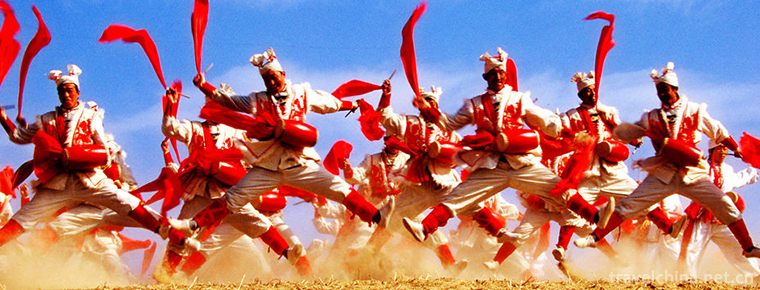
-
Cai Lun Zhuhai
Cai Lunzhuhai is located in Huangshi Town and Dayi Town, Leiyang City, a famous historical and cultural city in central and southern China. It covers an area of 100 square kilometers and has a central.
Views: 110 Time 2019-01-04 -
Baling Opera
Baling Opera, a local traditional drama in Yueyang City, Hunan Province, is one of the national intangible cultural heritage..
Views: 161 Time 2019-04-02 -
Production Techniques of Silk in Chengdu
Silk is the most distinctive traditional gold and silver handicraft of the Han nationality in Chengdu. This metal craft has a history of more than 1700 years. It has reached a very high artistic level.
Views: 209 Time 2019-04-18 -
Dong year
In Dong year, Dong language is called Ninggan, also known as Winter Festival or Yang Festival. Winter Festival was originally a festival of Yang surname of Dong nationality. .
Views: 343 Time 2019-04-27 -
Hejian song poem
Hejian Song and Poetry, Hejian City, Hebei Province, local traditional folk literature, one of the national intangible cultural heritage..
Views: 107 Time 2019-05-02 -
Firing Techniques of Liling Unglazed Colorful Porcelain
The firing technology of Liling Unglazed Five-color Porcelain, the local traditional firing technology of Liling Unglazed Five-color Porcelain in Hunan Province, is one of the national intangible cult.
Views: 165 Time 2019-05-13 -
Luonan Jing Blackboard
In 2011, Luonan Jingbanshu was approved by the State Council and listed in the third batch of national intangible cultural heritage list. As early as in the Daoguang period of the Qing Dynasty (around.
Views: 133 Time 2019-05-15 -
Nanxi chant
Nanxi chant is popular in Qianjiang District of Chongqing City. Its origin can be traced back to Tang Dynasty. Its embryonic form is Tujia peasants'work chant and folk song chant, which are similar to.
Views: 114 Time 2019-06-07 -
Cross stitch
Flower picking, a kind of drawing work, also refers to a needle method of embroidery, Chinese folk traditional handicraft. Also known as "pick weave", "cross embroidery", "cro.
Views: 230 Time 2019-06-21 -
Qing Opera of Wa Nationality
The Wa Qing Opera belongs to the high-pitched system, with different roles for men and women. The roles are similar to those of Sheng, Dan, Jing and Wei. Use a dye called "Red Drug" to colou.
Views: 107 Time 2019-06-25 -
Guangdong Opera YueJu
Guangdong Opera, also known as "Guangdong Opera" or "Grand Opera", is one of the traditional operas in Guangdong. It originates from Nanxi Opera and is popular in Guangdong and Gua.
Views: 173 Time 2019-07-16 -
Wuliangye distillery
Wuliangye Group Co., Ltd. is located at the intersection of Jinsha River and Minjiang River, the first city of the Yangtze River -- "Jiudu" Yibin. It is a modern corporate group with Wuliangye series liquor production as its main business.
Views: 327 Time 2020-10-16
